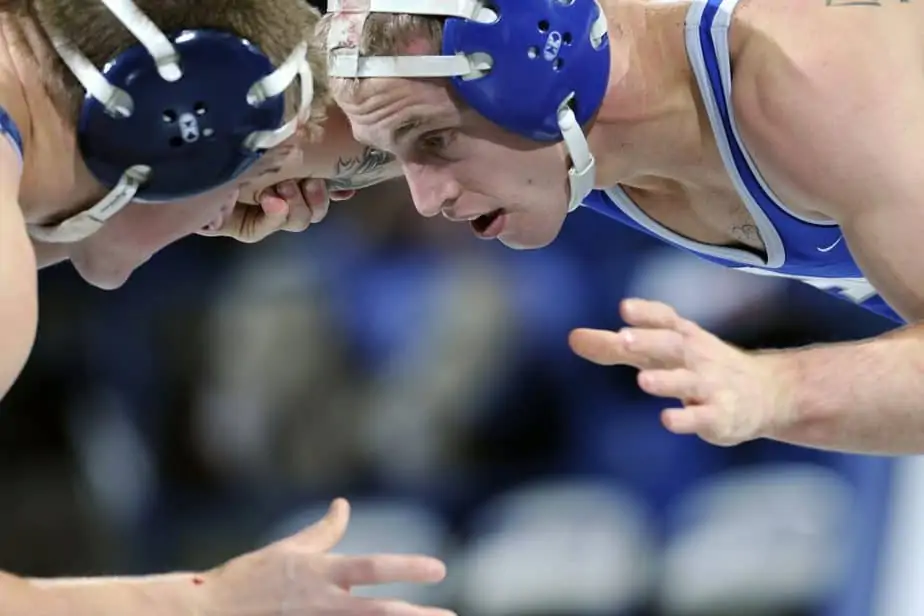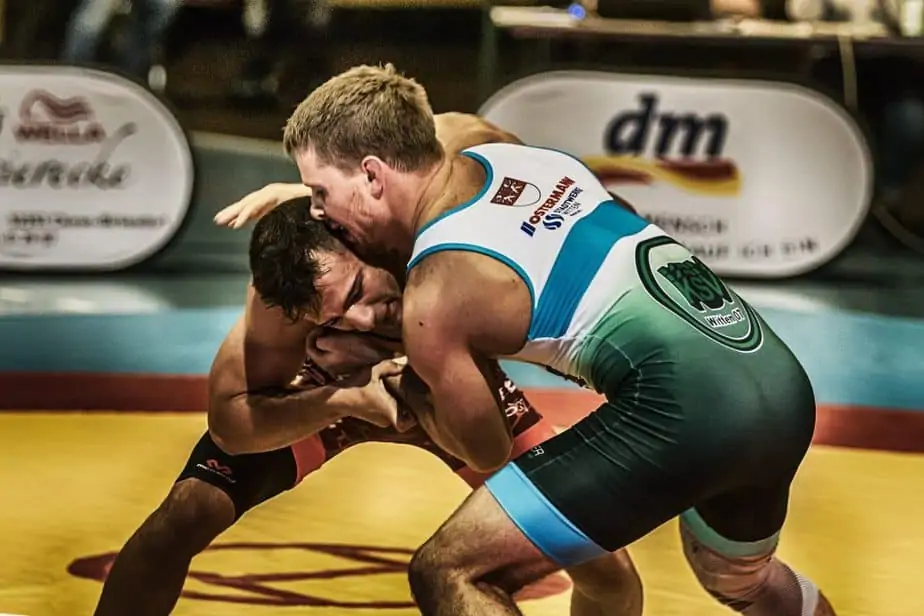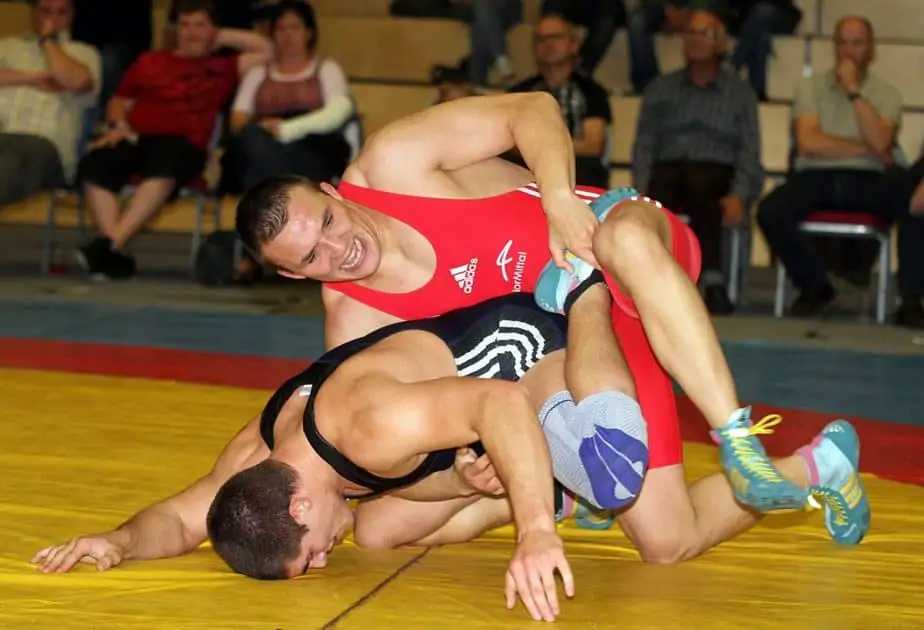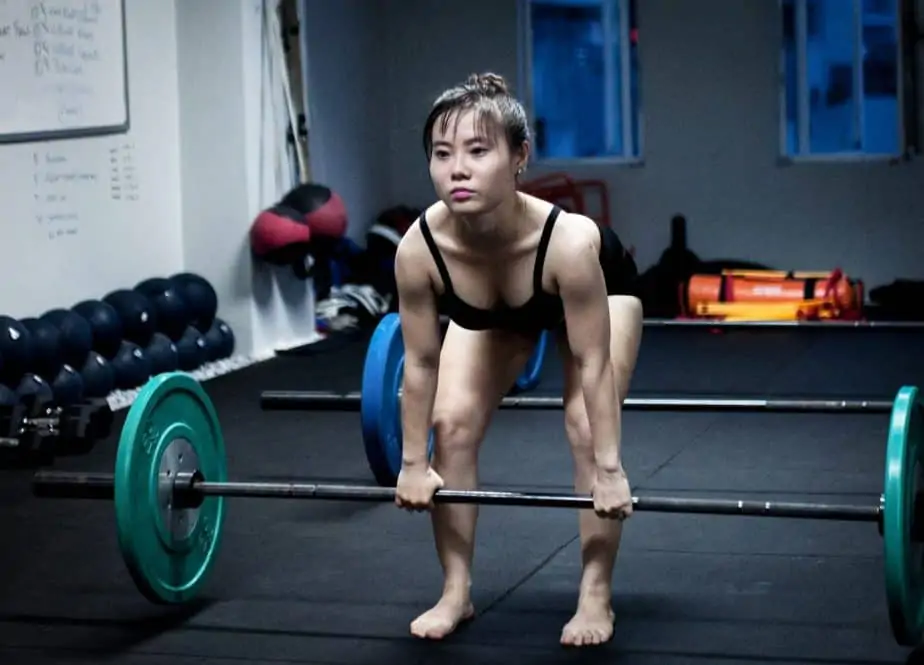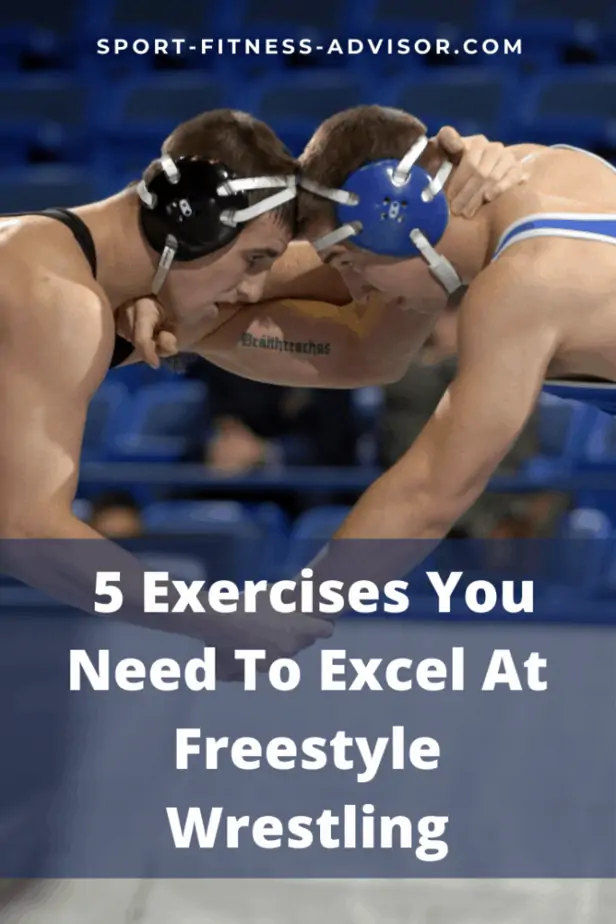Every freestyle wrestling gym has that one strong guy that everyone hates training with. Train with him and you can forget about getting out of bed the next day.
If you’re not “that guy”, you need to become as strong as him. People should fear training with you because of your strength and only then, will you excel at freestyle wrestling.
Luckily for you, there are a handful of exercises you can do regularly, to get strong fast and excel at freestyle wrestling.
In this post, you’ll learn;
- What is wrestling and why it’s the toughest sport ever
- How old-school wrestlers trained in the past
- The only muscle group you should focus on to build gorilla-like strength
- And the best 5 exercises that’ll make people fear your strength.
Let’s dive in!
What Is Freestyle Wrestling And Why Should I Care
Freestyle wrestling is the world’s oldest sport, dating back to the ancient Olympics in 708 BC. There are also cave paintings dating back over 15 000 years ago that show how people were tossing each other around for fun.
In the modern-day, freestyle wrestling is an art mainly practiced in high school and college, that involves taking your opponent down and controlling them. There are also different styles of wrestling that use different techniques and principles to take down and control the opponent. These styles include;
- Freestyle wrestling
- Greco-Roman wrestling
- Folkstyle wrestling
- And catch wrestling.
The two most common styles practiced in the Olympics are Freestyle and Greco-Roman.
The main difference being, Freestyle wrestlers can attack their opponent’s legs while Greco-Roman wrestlers may only use their arms and upper body to work for takedowns.
Freestyle wrestlers are typically more explosive since they have to get low, explode in on their opponent’s legs, and drive to score that a double leg takedown. Greco-Roman wrestlers mainly work for upper-body clinch positions and takedowns.
Now that we know what freestyle wrestling is and what separates it from the other arts, let’s find out why freestyle wrestling is the toughest sport on the planet.
Freestyle wrestling is the toughest sport, period.
Why Freestyle Wrestling Is The Toughest Sport Ever
If I could choose a skill that I’m good at, it’ll be freestyle wrestling.
Freestyle wrestling teaches you something that almost nobody knows how to do in the modern world. How to overcome adversity.
When you wrestle in high school, you compete over 50 times a year! Before you’ve even graduated, you’ve already competed over 200 times.
Competing so much creates a beast who can overcome almost anything. It teaches you to be comfortable in uncomfortable situations and how to develop a winning mentality.
In other martial arts like karate and jiu-jitsu, you’re taught to bow, obey your master, and respect your peers. These all have their place in training but walk into a wrestling gym and you’ll see a different level of toughness, competitiveness, domination, and mental strength.
Wrestlers are simply tougher, stronger, and faster than most athletes.
Why You Must Train To Be As Strong As Possible
Most newbies think that technique is all that matters, but this isn’t true because you’re bound to compete against someone who’s been wrestling for longer than you and you can’t match his technique. But if you’re stronger, you can use that to tip the scale in your favor.
You need to reach your genetic strength limit because you’ll be competing against hundreds of beasts that are stronger, fast, and better than you..
I’ve seen many experienced college wrestlers who make mistakes that most students correct in their first week, but they are just so strong and explosive, it doesn’t matter.
Now we know that strength is important, but how did ancient wrestlers train to get strong?
Ancient Greek wrestlers were badasses
The History Of Strength Training For Freestyle Wrestlers
Ancient Greek wrestlers never had access to machines, barbells, and weights, so they made the most of what they had. And they looked ripped with perfect symmetry and proportion.
Have you ever seen an ancient Greek statue? That looked like Gods. Much better than most bodybuilders today.
Greek wrestlers trained with heavy stones, sandbags, small dumbbells, bodyweight exercises, and carrying their partner’s bodyweight. This is how all wrestlers must train. Use awkward and functional exercises because wrestling is awkward and functional, and avoid exercises that have no carryover to your sport.
I’m not hating on the bench press or bicep curls because we all love them, but focusing on them instead of functional exercises like deadlifts will get you far fewer results.
But which muscles should I focus on as a freestyle wrestler?
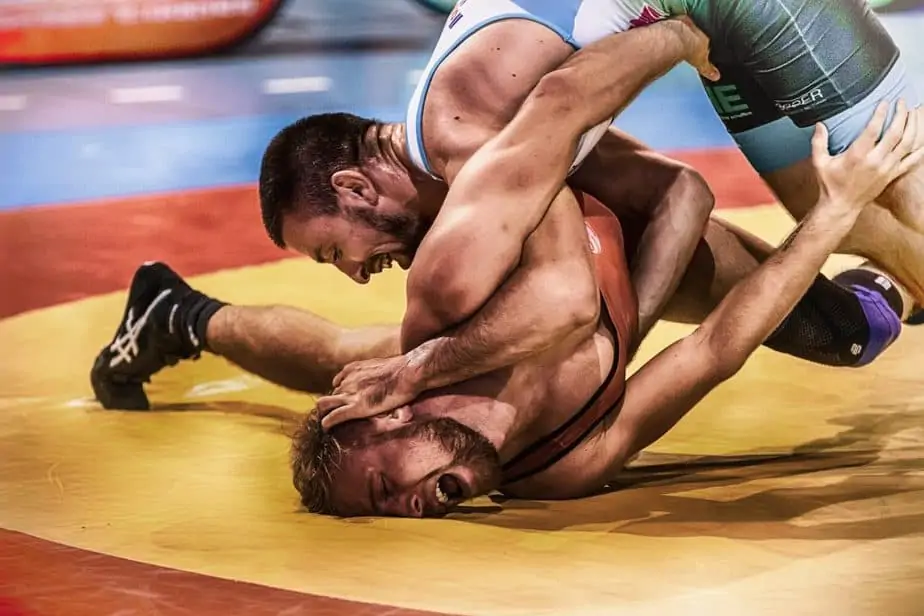
The Main Muscles Needed For Freestyle Wrestling
I’ve seen plenty of weight training programming for freestyle wrestlers online and at high school programs. And almost all of them undertrain this one muscle group.
And guess which muscle group almost every freestyle wrestler under trains?
Your pulling muscles!
These muscles include;
- Traps
- Lats
- Rear Delts
- Hamstrings
- Glutes
- And erectors.
These muscles are called the posterior chain.
It’s most involved with picking people up and controlling them because you must be good at pulling your elbows in, against force.
Think of any wrestling takedown or technique like the double leg takedown, single leg takedown, or body lock, they all heavily emphasize your pulling muscles. And if you don’t emphasize your pulling muscles during training, don’t expect to win any trophies.
Another reason why you should heavily emphasize your posterior chain is because modern life weakens it. 90% of the time we’re sitting at our desks at work or watching TV. These activities over-activate your anterior chain while under-developing your posterior chain.
This leads to lots of modern-day problems like back pain and poor posture.
Now imagine your posterior chain is already weaker than normal, and you aren’t putting any emphasis on it during training. This doesn’t only hamper wrestling performance, but it can cause serious muscle imbalances.
The solution? Pull twice as much as your push.
This won’t only optimize your performance, but it’ll fix any muscle imbalances you’re suffering from.
For example, if you’re doing 15 pushups, balance it out with 30 pullups. If you’re doing 3 sets of bench press, complete 6 sets of bent-over rows.
Always pull before you push.
Another way of strengthening your posterior chain is to do your pulling exercises before your pushing exercises. For example, do some bent-rows before you hit the bench or get under the pullup bar before doing some overhead presses.
You might be wondering, “How can this possibly benefit me? I’m already pulling twice as much?”
Well, it stabilizes your scapula, which is essential to improving your pressing exercises like the bench press.
By doing some bent-rows before you hit the bench, you create more stability for your shoulders to perform in the second exercise. Your rotator cuff is connected to your scapular and by increasing blood flow in this area before you press can prevent injury and shoulder instability.
Freestyle wrestlers compete around 50 times a year, and if you suffer a shoulder injury caused by something as simple as pressing first, it’ll take precious time to recover.
The overall benefits of emphasizing your pulling muscles are;
- Increased performance on the mat
- Healthier shoulder joints
- More balanced muscles
- And pain-free pressing.
Freestyle wrestlers are known for their insane work ethic, but sometimes this may cause serious injury right before an important tournament. So how do you prevent injury, while getting stronger?
How To Prevent Injuries While Lifting Weights
Freestyle wrestlers need to find that sweet spot between training hard and not getting injured. Don’t train hard enough and you’ll head into competition weaker and less technical than normal. Train too hard and you’ll injure yourself.
That’s why a freestyle wrestler needs to build a deep relationship with his or her body and understand when to train more and what’s overtraining.
But here are a few extra tips to prevent you from getting injured.
Warm Up With Some Cardio
Warming up is almost like revving your engine to increase body temperature and blood flow to your muscles. Doing this reduces your chance of injury.
When warming up, exercise at a slower and less intense pace than usual.
Focus on large muscles like your hamstrings, quads, back, and glutes, as they are put under the most pressure while training.
The best way to warm up for freestyle wrestling practice is to jog for 10 minutes as this will pump blood into your quads, glutes, and hamstrings. Next, do a handful of jump squats and pullups just to get your body to explode like it would during sparring. Lastly, playfully spar with a partner you trust. Someone who left their ego at the door. Doing this will get you into the groove for real training.
Always cool down before you hit the showers
Cool Down With Light Stretching
After a long and hard session of wrestling, most just want to hop in the shower and head home. But this might cause harm.
After training, your heart is beating through your chest, your body temperature is sky high, and your blood vessels are dilated. If you go from intense training, to immediately stopping, you might feel nauseous, dizzy, or even pass out.
Luckily, there’s a quick fix. Simply stretch for 10 to 15 minutes after training.
Some common cool down stretches are;
- The single-leg hamstring stretch
- Standing quad stretch
- And the cobra stretch.
All these stretches involve your posterior chain muscles and this ensures you recover efficiently for your next training session.
Stay hydrated!
Stay Hydrated During Training
According to Sports Dietetics Australia, as your body loses fluids through sweating, your ability to perform physically and mentally drops. The exercises you perform also feels harder than it actually is and your risk of injury increases.
This is because the water you lose not only hydrates you, it contains essential electrolytes like sodium, magnesium, and potassium that help you reach peak performance.
Muscle mass is 70% to 75% water.
To ensure you’re properly hydrated, drink 16 ounces of water, 4 hours before you start wrestling or lifting and another 8 ounces, 20 minutes before you start training. This will give your body the water needed to stay hydrated.
Also, don’t forget to bring a water bottle with you to the weight room and sip on it in between sets.
Know when to stop!
Know When To Stop And Slow Down
There’s a big difference between giving up and knowing when to stop, and most martial artists, especially wrestlers don’t know the difference.
When you’re training for a competition and you’re getting sick all the time because your immune system is shot, it’s time to stop and slow down. If you’re constantly getting injured due to intense training, it’s time to stop and slow down.
Reduce the number of training sessions you attend and start lifting sub-optimal weights. This will give your muscles, nervous system, and immune system time to recover and come back stronger.
Now that we know how to avoid getting injured, let’s cover the only 5 exercises you’ll ever need to get stronger at freestyle wrestling.
Pull ups build a massive back.
Pull-ups
We’ve already established that freestyle wrestling is a pulling sport. Everything you do from double leg takedowns to single leg takedowns, and sprawls, all emphasize your pulling muscles.
And guess what’s the king of all pulling exercises? The pull-up!
Some say that the deadlift is the king of all pulling exercises and they might have a strong case to back that up, but deadlifts are extremely taxing on your central nervous system. Try doing heavy deadlifts 4 times a week and see how long you’ll last before you burn out.
Pull-ups are great since you can do a lot of volume without taxing your central nervous system and burning out. They’re also convenient because you only need a bar to pull up from.
Pull-ups, when done correctly and with enough volume can build gorilla-like grip strength and insane core strength. Both are crucial for freestyle wrestling competition.
How To Properly Perform A Pullup
Pull-ups are one of the simplest exercises to perform.
Hang from a pull-up bar with your palms facing away from your body. Retract your scapula by pulling your body up without bending your arms. Doing this will protect your shoulders against injury. Next, instead of trying to pull your body up, think of bringing your elbows towards the floor. This will engage your lats more and give an awesome mind-muscle connection.
Once your chin is over the bar, slowly lower yourself down and repeat.
Carryover To Freestyle Wrestling
The pull-up builds strength by pulling your elbows in and down against your own bodyweight. Think of any freestyle wrestling technique, most involve pulling your elbows in and down against force. And if you’re used to that, completing that single leg takedown will be a piece of cake.
Now that we’re doing pull-ups as our primary pulling exercise, it’s time to add a secondary pulling exercise.
Deadlifts strengthen your entire organism.
Deadlifts
Deadlifts might be taxing on your central nervous system, but it works almost every muscle in your entire body. Everything from the muscles in your neck to the muscles in your feet. It also emphasizes your posterior chain by strengthening your glutes, lower back, hamstrings, traps, and lats.
Deadlifts also build grip strength like no other exercise.
How To Deadlift Without Injuring Your Back
The deadlift is a bit tricky. It’s simple and easy to learn, yet most do it wrong and end up injuring themselves.
But here’s a simple 5 step deadlift setup to ensure you deadlift with proper form every single time.
- Walk over to your barbell and place you midfoot directly under the barbell. Your shins will be about one inch away from the bar and your feet 6 inches apart.
- Lean over with stiff legs and grip the bar just outside your knees. Don’t move the bar! If you do, then start over.
- Touch the barbell with your shins. Again, don’t move the bar!
- Bring your chest up and squeeze the muscles in your back. Be careful not to drop your hips as this will cause you to use more quads and less posterior chain.
- Pull the bar up your legs while keeping your spine straight.
And that’s it! You’re well on your way to getting stronger.
Carryover To Freestyle Wrestling
Deadlifts don’t only strengthen your posterior chain, it strengthens your whole organism. They will allow you to train harder for longer while protecting your joints, bones, and ligaments against injury.
Now let’s move on to the deadlifts little brother, power cleans.
Power Cleans
Power cleans are similar to deadlifts but they have an extra step. Instead of ending above your knees, the power clean ends in a front squat position.
The power clean is commonly used by athletes to build explosive power, coordination, and speed.
The purpose of the power clean is to not only move a heavy barbell but to move it as fast as possible.
How To Power Clean
It’s quite difficult to learn and perform the power clean on your own without a coach or partner to help you. So I’d suggest asking a friend who already knows how to power clean to show you, but here’s the basic setup of power cleaning with good form.
- Get into a deadlift position and lower your hip so your thighs are parallel to the ground.
- Pull the bar into the top of a deadlift position. This is called your first pull.
- Now you’re going to complete your second pull by bending your knees slightly, jumping up straight, and extending your hips while shrugging the bar.
- Finally, drive your elbows forward and around the barbell and stand up straight.
The power clean takes months to master. But once you do, it builds more explosive power than any other exercise.
Carryover To Freestyle Wrestling
The power clean builds explosive power by trying to move the barbell as fast as possible. When you’re wrestling, explosion is key. You want to get low and explode and take your opponent down. If you’re defending a takedown, your goal is to bring your hips back and sprawl explosively to avoid getting taken down.
If you’re performing power cleans regularly, your explosive power will increase and your opponent won’t even see your takedown coming.
Zercher Squats
The Zercher squat is an awesome, awkward exercise that’ll strengthen your traps, lower back, glutes, and quads. It’s similar to an exercise that many ancient Greek wrestlers performed where they’d hold heavy sandbags in the crooks of their elbows and squat.
How To Perform A Zercher Squat
To perform the Zercher squat, place the bar in a squat rack around the height of your elbow. Wrap your arms around it and grab your upper traps to create upper body stability.
Take a step back and squat down with your torso upright, similar to the angle of a front squat. And when your hamstrings touch your calves, stand back up.
Carryover To Freestyle Wrestling
The reason every single freestyle wrestler should perform the Zercher squat is that it emulates the position at the bottom of a double leg takedown.
If you can Zercher squat more than what your opponent weighs, then all you need is to get low and deep and the rest is easy.
Sprints
Running on a treadmill builds cardio and endurance for long distances. So it’ll make no sense to do that since freestyle wrestling matches are only 5 minutes. This is where sprints come in. Sprints build explosive, short term cardio that’s perfect for freestyle wrestling tournaments.
How To Sprint
Go outside with a friend and put a timer on for 20 seconds. Measure how far you can sprint in these 20 seconds and do 3 sets. Repeat this every day for 5 days a week and measure your improvements.
Carryover To Freestyle Wrestling
Sprinting builds explosiveness and short term cardio which are great for freestyle wrestling tournaments.
Conclusion
Freestyle wrestling is a sport that takes lots of time to master and it’ll be counterproductive to spend precious time doing exercises that have no carryover to your sport. But you shouldn’t just ignore strength training also.
So to create balance, stick to these 5 exercises as it won’t take much time and you’ll get more bang for your buck. Now I’d like to hear from you, which is your favorite exercise?

Jacky has a degree in Sports Science and is a Certified Sports and Conditioning Coach. He has also worked with clients around the world as a personal trainer.
He has been fortunate enough to work with a wide range of people from very different ends of the fitness spectrum. Through promoting positive health changes with diet and exercise, he has helped patients recover from aging-related and other otherwise debilitating diseases.
He spends most of his time these days writing fitness-related content of some form or another. He still likes to work with people on a one-to-one basis – he just doesn’t get up at 5am to see clients anymore.

